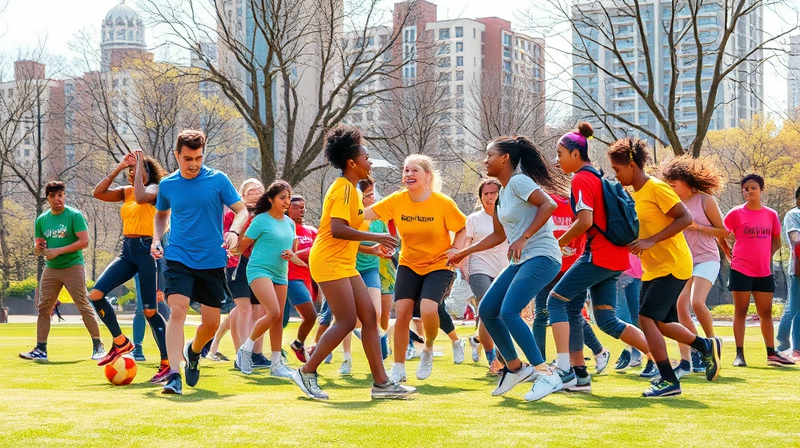In today’s competitive sports landscape, athletes are always seeking new methods to boost performance and gain an edge. One powerful strategy is to embrace diverse training approaches such as cross-training and multi-sport participation. By exploring various athletic pursuits, you not only become a more versatile competitor but also a well-rounded individual with robust physical and mental strengths.
Embracing diversity in training can be one of the most inspiring ways to refine your skills. Engaging in multiple sports develops a broad range of motor skills, enhances overall athleticism, and importantly, helps reduce the risk of overuse injuries. This balanced approach creates a unique foundation that supports continual growth and resilience in a competitive environment.
The Power of Multi-Sport Participation
Recent studies have shown that young athletes who participate in several sports are more likely to build effective fundamental skills that transcend a single discipline. An inspiring example of this is the statistic showing that 77% of professional athletes engaged in multi-sport activities during childhood. This reinforces the idea that exploring different sports is not only fun but incredibly beneficial.
Participating in various sports teaches you new skills and strengthens your ability to adapt to different game pressures and strategies. It also ensures that you continually challenge your body in different ways, thus fostering quicker recovery, resilience, and even mental sharpness.
Cross-Training: A Catalyst for Comprehensive Fitness
Cross-training means deliberately integrating activities outside your primary sport to complement your training routine. This practice is key to developing balanced fitness because it targets different muscle groups and enhances overall endurance. Each new activity brings its unique benefits:
- Enhanced Cardiovascular Fitness: Engaging in a variety of exercises can help boost your heart health and increase overall endurance, making your primary sport feel easier over time.
- Improved Strength and Flexibility: By working different muscle groups, cross-training promotes balanced muscle development and enhances flexibility beyond what single-sport training can offer.
- Reduced Risk of Injuries: Alternating workouts allow certain muscle groups to rest and recover while others are engaged, assisting in injury prevention.
- Mental Refreshment: Shifting your training routine by incorporating various activities keeps the experience engaging and helps prevent burnout.
This variety means that every training session brings an opportunity to build strength, endurance, and flexibility, making every practice session more meaningful and exciting.
Complementary Sports for Skill Transferability
When choosing complementary sports, think about how the skills you learn in one area might be useful in another. For instance, a soccer player might try basketball to boost agility and improve footwork, while a swimmer could benefit from the additional cardiovascular challenges of cycling. By exploring activities that enhance your strengths, you can refine your abilities in your primary sport, reinforcing your performance with added versatility.
Examples of complementary sports include pairing tennis with badminton, or even integrating martial arts into a training schedule to boost both coordination and balance. The key is to choose activities that nurture transferable skills.
Developing Fundamental Movement Skills
At the heart of multi-sport participation is the development of fundamental movement skills. These skills, like coordination, balance, and agility, act as the building blocks for any athletic performance. Practicing these fundamentals across diverse sports opens up new avenues for growth in your primary discipline.
Building physical literacy by engaging in multi-sport training leads to a more robust understanding of body mechanics. This not only offers an edge over competitors but also instills habits that contribute to long-term athletic success and injury prevention.
Periodization and Recovery: The Cornerstones of Success
Engaging in multiple sports simultaneously demands a well-structured training program. Periodization is essential; it involves planning your training in macrocycles, mesocycles, and microcycles that align with season-specific demands. This structured approach allows you to maintain peak performance across different sports throughout the year.
In addition to periodization, prioritizing recovery is paramount. With increased activity comes increased strain on your body. Incorporate strategies like active recovery, proper nutrition, hydration, and sufficient sleep. Dedicating time to recovery ensures that you remain at your optimal performance level and prevents burnout and injuries over the long run.
Nurturing Mental Toughness
Perhaps one of the most significant benefits of engaging in diverse athletic activities is the growth of mental resilience. Each sport introduces unique challenges, encouraging you to develop a strong sense of adaptability and problem-solving. Overcoming hurdles in one discipline can enhance mental toughness in another.
Developing mental resilience isn’t just about physical endurance. It’s about cultivating a mindset that finds motivation in challenges and uses them as opportunities to learn and improve. This mental toughness will be a game changer, not only within sports but in every aspect of life.
Maintaining Focus on Sport-Specific Skills
Even while embracing the benefits of multiple sports, it is essential to keep your primary sport at the forefront of your training. Allocating time for focused, sport-specific drills guarantees that while your training is diverse, your main area of expertise remains polished and sharp.
Striking a balance between diversified training and sport-specific practice can be challenging, but it is crucial for achieving overall athletic excellence. This balanced approach enables you to enjoy the benefits of multiple sports training without compromising the development of specialized skills.
Ultimately, the journey to enhanced athletic skill is about expanding your boundaries, diversifying your methods, and embracing the full range of challenges and opportunities available. Experience the true joy of sports by remaining passionate, resilient, and open to new ways of training. Let your athletic journey inspire you to keep pushing forward, building on the strong foundation of varied and comprehensive sports engagement.
Remember, the key to exceptional athletic performance is not simply in focusing on one discipline, but in discovering the immense benefits of a well-rounded approach. Embrace the full spectrum of training opportunities and become the strongest, most agile athlete you can be.








